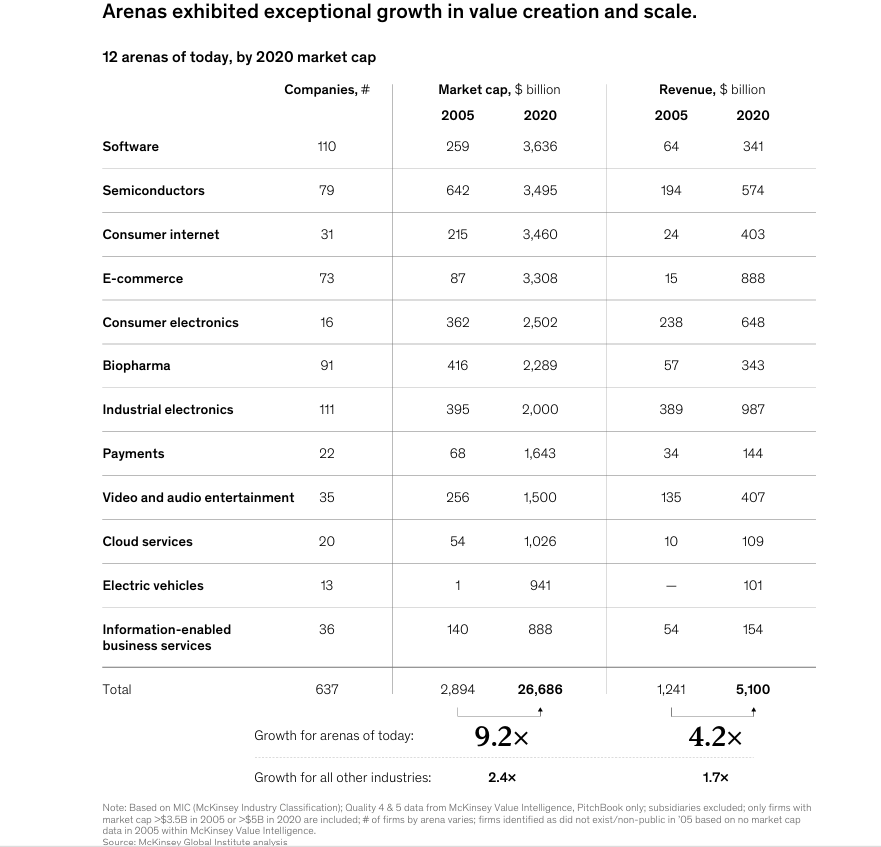According to a McKinsey report, from 2005 to 2020, several industries around the world experienced significant growth and reshaping of the market landscape, especially in the emerging technology sector. Compared to the average annual growth rate of 4% for the overall industry, these emerging sectors have grown by as much as 10% per year, and their share of the global market has also increased significantly. Especially in areas such as cloud computing, e-commerce, and consumer internet, industry leaders such as Google, Amazon, Facebook, and Microsoft are driving the rapid expansion of the market.
E-commerce: from marginal markets to core industries
The rise of e-commerce is one of the most significant industry changes. In 2005, the industry's revenues were only $15 billion, accounting for 0.1% of global revenues across all industries; But by 2020, that number had jumped to $890 billion, or 2.4 percent. In terms of market capitalization, the e-commerce industry was only $87 billion in 2005 (0.35% of the global market), and by 2020, its total market capitalization has reached $3.3 trillion, accounting for 4.2% of the global market. Among them, Alibaba, Amazon and JD.com contributed 63% of revenue growth and 64% market capitalization growth, becoming the core drivers of the industry.
Consumer Internet & Cloud Services: The Rise of Tech Giants
The consumer Internet industry has also experienced rapid development. In 2005, the market capitalization of the industry was $215 billion, accounting for 0.87% of the global market; In 2020, this figure soared to $3.5 trillion, accounting for 4.4%. Tech giants such as Alphabet, Meta, and Tencent dominate this space.
The growth of cloud computing services was mainly due to the rise of AWS and Microsoft Azure. In 2005, the market value of the cloud services industry was only $54 billion, accounting for 0.2% of the global market; By 2020, its market capitalization had exceeded $1 trillion, accounting for 1.3%.
Smartphones are driving the restructuring of the consumer electronics industry
The consumer electronics industry has also experienced a round of fierce market competition and corporate reshuffle. In 2005, the industry had a total revenue of $238 billion, with Sony topping the list with $64 billion (27%), followed by LG ($41 billion, 17%) and Samsung ($32 billion, 14%). However, by 2020, the rise of smartphones had completely changed the market landscape, with total industry revenue growing to $648 billion, with Apple dominating with $192 billion (30%), Samsung ($88 billion, 14%) remaining at the top, and Sony and LG being squeezed into fourth and fifth place.
In addition, the dynamics within the industry are also very drastic. BlackBerry, for example, grew from $2 billion in 2005 to nearly $20 billion in 2010, but fell again to less than $2 billion in 2015, reflecting the fierceness of the market.

Figure: Various sectors have shown extraordinary growth in terms of value creation and scale
The sharp reshuffle in the semiconductor industry
McKinsey pointed out that the market landscape of the semiconductor industry has changed dramatically in just a few years. In 2020, the sector's market capitalization reshuffle rate was 41%, the lowest of any emerging industry. However, by 2024, this number surged to 87%, largely driven by Nvidia's soaring market capitalization. This trend suggests that the semiconductor industry is likely to continue to undergo a larger market restructuring with breakthroughs in AI technology.
Emerging Industries at a Glance: Technology Leads the Future
As of 2020, the top 12 industries by market capitalization in the world span a number of technology-driven sectors:
1. Software: Microsoft, Oracle, Adobe and other software companies, mainly providing enterprise and consumer software and SaaS services.
2. Semiconductors: Intel, TSMC, Nvidia and other companies, as well as semiconductor manufacturing equipment supplier ASML.
3. Consumer Internet: Internet service companies such as Alphabet, Meta, and Tencent.
4. E-commerce: e-commerce business of e-commerce platforms such as Amazon, JD.com, Alibaba, and traditional retailers.
5. Consumer electronics: Apple, Samsung and other smartphone, tablet, wearable device manufacturers.
6. Biopharmaceutical: Biopharmaceutical business of gene medicine companies such as Amgen and Regeneron, as well as traditional pharmaceutical companies such as Pfizer and AstraZeneca.
7. Industrial electronics: electronic manufacturing service providers such as Foxconn, Jabil, Flex, etc., and industrial electronic equipment manufacturers such as Panasonic, Siemens, and ABB.
8. Payment: Payment networks and transaction service providers such as Visa, Mastercard, American Express, etc.
9. Video & Audio Entertainment: Streaming and broadcasting companies such as Disney, Netflix, Paramount, and record labels such as Warner Music.
10. Cloud computing: AWS, Microsoft Azure, Google Cloud, and other enterprises that provide cloud storage and computing services.
11. Electric vehicles: Electric vehicle business of pure electric vehicle companies such as Tesla and BYD, as well as traditional car companies such as Toyota, GM, and Mercedes-Benz.
12. Information services: Deloitte, S&P, Experian and other data analysis, business services and credit rating companies.
Over the past two decades, technology-driven industry changes have accelerated the market reshuffle, with emerging sectors growing much faster in terms of revenue and market capitalization than traditional industries. Whether it's cloud computing, e-commerce, semiconductors and consumer electronics, the dynamics of market competition are intensifying, and the future landscape will continue to evolve with technological advancements.
Related:
18 Potential Arenas of the Future That Could Reshape the Global Economy (1)
18 Potential Arenas of the Future That Could Reshape the Global Economy (2)
18 Potential Arenas of the Future That Could Reshape the Global Economy (3)
18 Potential Arenas of the Future That Could Reshape the Global Economy (4)






